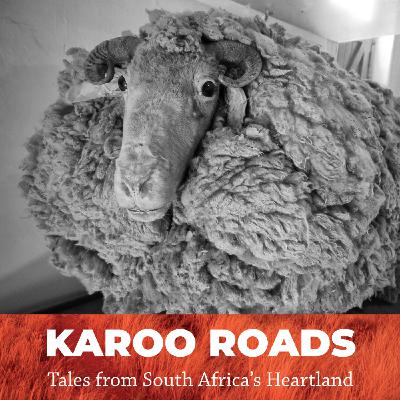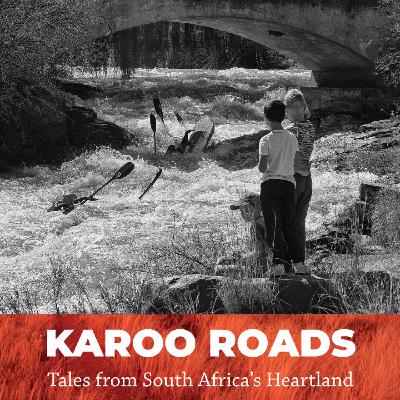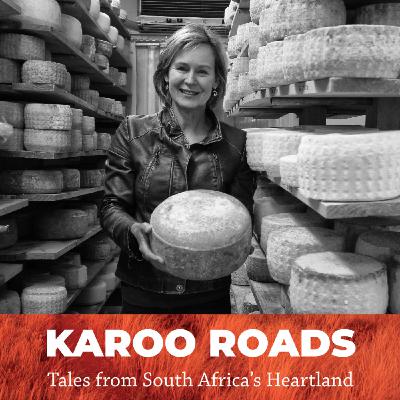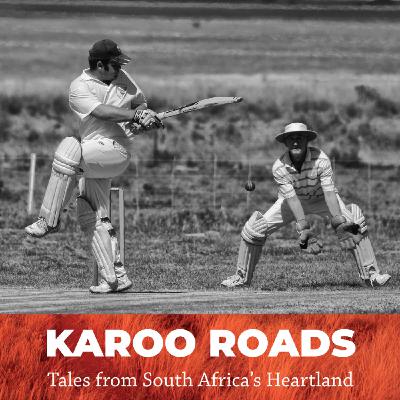Discover The Karoo Roads Companion
The Karoo Roads Companion

The Karoo Roads Companion
Author: Radio Life & Style
Subscribed: 0Played: 6Subscribe
Share
© Radio Life & Style
Description
The companion podcast to the "Karoo Roads" Book Series: a massive quilt of magic stories, brought to you from the Outback of South Africa - written, photographed and published by Julienne du Toit and Chris Marais.
the Karoo Roads series is a collection of more than 60 outstanding Karoo stories in three books, gathered over 20 years of rambling on dirt roads and forgotten highways, in snow and sunshine.
Many of the characters in them, like Matjiesfontein’s David Rawdon, Outa Lappies of Prince Albert, Group Captain ‘Dutch’ Hugo of Pampoenpoort Farm, Alfie Wewege of Port Nolloth, the Elders of Lekkersing village in the Richtersveld and a slew of old-time steam train drivers from De Aar, have since passed on. But, in these pages, they live and breathe once more.
Through these three books you will discover the hidden stories of the Karoo. You will discover a rock star traffic cop, a world-class farm school, a couple who live in a castle, an Old School newspaperman with the highway in his eyes and a desert festival that lights up the Tankwa skies every year.
Light the fire, pour the drink, sink into your favourite chair and join us on a series of adventures and discoveries.
To buy this book series, just email Julie at julie@karoospace.co.za or visit the book section of our website, karoospace.co.za.
the Karoo Roads series is a collection of more than 60 outstanding Karoo stories in three books, gathered over 20 years of rambling on dirt roads and forgotten highways, in snow and sunshine.
Many of the characters in them, like Matjiesfontein’s David Rawdon, Outa Lappies of Prince Albert, Group Captain ‘Dutch’ Hugo of Pampoenpoort Farm, Alfie Wewege of Port Nolloth, the Elders of Lekkersing village in the Richtersveld and a slew of old-time steam train drivers from De Aar, have since passed on. But, in these pages, they live and breathe once more.
Through these three books you will discover the hidden stories of the Karoo. You will discover a rock star traffic cop, a world-class farm school, a couple who live in a castle, an Old School newspaperman with the highway in his eyes and a desert festival that lights up the Tankwa skies every year.
Light the fire, pour the drink, sink into your favourite chair and join us on a series of adventures and discoveries.
To buy this book series, just email Julie at julie@karoospace.co.za or visit the book section of our website, karoospace.co.za.
4 Episodes
Reverse
A mission to find the Golden Fleece of the Karoo begins and ends in the Calvinia Museum.
The opening chapter of Karoo Roads III by Chris Marais and Julienne du Toit is all about the wondrous apparitions to be found at the Calvinia Museum in the Northern Cape.
The authors go on a road trip with the aim of discovering The Poggenpoel, said to be the shaggiest sheep in South Africa. En route, they bring a thunderstorm to the drought-stricken town, and uncover some of the most unusual artefacts you’ll ever find in a country museum:
- A section wholly dedicated to the Lombard Quads of Loeriesfontein. Born in Calvinia in 1951. Klasie, De Waal, Jan and De Villiers all turned 70 sometime this year. The room comes complete with four child-sized dolls dressed in bowties, waistcoats and cricketing whites (each holding a little shepherd’s crook), four walking rings, four cots, four christening robes, four baby’s bonnets and what looks to be four toddler-leashes for controlled outings.
- Trekboer Corner, with an ageing diorama of a settler couple completely engrossed (as they have been for many, many years) in preparing supper in their outdoor asbos skerm (lye bush shelter). There’s even a glow in the fire.
- A corner dedicated to the 120-odd Jewish families who once lived in Calvinia.
- A four-legged ostrich chick that was shown to farm kids for a penny at a time.
- A classic 1952 Ford V8 bakkie, with its distinctive white grille. In the Wool Boom decade of the 1950s, it was a farmer’s favourite, full of style and attitude.
- The Makadas Class 24 steam loco that used to haul Calvinia’s wool to Williston, then to Hutchinson and finally onto the main line to the markets of old Port Elizabeth (now Gqeberha).
- A huge sheep that once belonged to Danie Poggenpoel, from Bonekraal Farm up in the Roggeveld Mountains. It went AWOL from its flock for a few years and skipped many shearing seasons. It was so remarkably tatty that the farmer kept it like that and, when it died, had it stuffed and donated to the Calvinia Museum.
“These marvellous old platteland collections of memories are a priceless lifestyle window to long-gone eras of the Karoo,” says co-author Marais. “They often tell you more about rural communities than a history book could ever do.”
For an insider’s view on life in the Karoo, get the Three-Book Special of Karoo Roads I, Karoo Roads II and Karoo Roads III by Julienne du Toit and Chris Marais for only R760, including courier costs in South Africa. For more details, contact Julie at julie@karoospace.co.za The Karoo Space Website
Each year, hundreds of canoeists are drawn to a remarkable river that runs through a dry land...
By Julienne du Toit
"Every springtime, an old gap-tooth crocodile called Cecilia makes her appearance on the banks of the Great Fish River in the Eastern Cape Karoo. She lurks quietly, content to bask among the river reeds north of Cradock.
Cecilia only ever appears when there are a few hundred paddlers riding the lively rapids. Welcome to the amazing Fish River Canoe Marathon.
The Fish, as it is fondly nicknamed, had grown to become one of South Africa’s premier river races, along with the Dusi Canoe Marathon in KwaZulu-Natal, and the Berg River Canoe Marathon north of Cape Town.
Day One
The start of the race always falls on a Friday.
First light reveals a steady convoy of bakkies and SUVs heading up the N10 from Cradock. They are topped with canoes on roofracks and sport registration plates from all over the country. They turn onto the dirt road to Grassridge dam, silken dust floating behind them over the Karoo bossies and lucerne fields.
At the dam, there is organised chaos.
Beside little clusters of canoes, competitors are affixing race numbers to bodies, paddles and boats. They wiggle their rudders, don helmets and caps, fill their water reservoirs (trippers), coordinate rendezvous times and places with their seconds, slather on sunblock, test their GoPro cameras and effect last minute reinforcements with duct tape. A drone whines overhead to capture the action.
A hatted man with an epic beard, megaphone, and German Shepherd Dog announces: “One minute.”
“Ready? Go!” The group sprints to the water. Within seconds, they’re into their canoes, stretching the elasticated splashies over the opening. Wobble, balance and they’re off into the rising sun, paddles churning, water drops flying.
The first hazard after the dam wall on the far side is the high weir and chute nicknamed Double Trouble on Norman Collett’s farm.
Keith’s Flyover
Before long, the first in the batch are at Adamsfontein Farm, home of Ted and Ingrid Collett. Here the Great Fish River hurtles through a winding rocky channel under a bridge named Keith’s Flyover.
The water madness calms down a little until Soutpansdrift rapid, where Sinclair and Mary Collett farm. Then it’s a comparatively easy dash to Day One’s finish line at Knutsford, where farmers’ wives feed the paddlers boerewors rolls and a mystery soup that has all the seconds clamouring for the recipe. The secret? The local women all make part of the soup in their own kitchens. Everyone’s soup is then merged together in a huge tureen. It’s delicious.
Heroism, Fun and Cecilia
The visual highlight of Day Two is the Cradock Weir.
Under its distinctive high V-shaped edge is a wicked churning tumble of whitewater. On a platform in front of the weir’s edge are the lifesavers, muscular young men clad in red lycra, tethered so that they can be pulled back quickly during a rescue.
Like Keith’s Flyover, this is one of the most exhilarating obstacles, for competitors and spectators. From early, locals bring snacks, drinks and sit down to watch the drama. The views are good from several vantage points, including a grassy bank, and the bridge over the river, in front of the weir.
And Cecilia? She has had her moment of glory. The paddlers that have seen her have identified her location in the Spot the Croc competition, hoping to win a brand new canoe.
On Sunday, Roy Copeman picks her up in his bakkie and stashes her rigid leathery form in the Cradock clubhouse. There Cecilia, named after Cecil Hennig the local taxidermist, quietly gathers dust until the next year’s outing."
This is an extract from Karoo Roads III – The Adventure Continues, by Chris Marais and Julienne du Toit. For author-signed, first-edition copies of Karoo Roads III, email Julienne du Toit at julie@karoospace.co.za The Karoo Space Website
Surviving hard times with faith, hope and a slice of Karoo Crumble...
By Julienne du Toit
'By 2019, the Karoo had been crippled by a six-year drought that had left the veld blackened, the dams emptied, and farming families destitute. Trucks criss-crossed the country with donated fodder in an effort to keep enough sheep and animals alive long enough to restart when the rains finally came.
Williston in the Northern Cape was one of the worst hit districts. Many farmers had no choice but to give up. Others, like Peter Schoeman of Langbaken Farm, found a way to hold on.
Peter and his wife Francy experienced the worst of the drought, but they also witnessed first-hand the strength of their community, the daily faith that kept everyone going, the kindness of other farmers around the country who sent aid.
The Schoemans and their workers survived in part thanks to a very unusual ‘cash’ crop in the Karoo. Francy is a cheesemaker. Throughout the drought, they were able to keep 12 Jersey cows thriving and producing milk, and every few days, they made a few dozen more wheels of cheese. Every week, the courier arrived to pick up wheels of cheese sent in refrigerated boxes around the country.
Finally, at the end of 2021, the drought relented. The long-awaited rains came, and the veld that had seemed dead sprang to life. The long-dry Sak River ran full, bank to bank. An elated Francy wrote: “The Karoo is laughing and dancing! The time for weeping and mourning has passed.” '
...................................
For an insider’s view on life in the Karoo, get the Three-Book Special of Karoo Roads I, Karoo Roads II and Karoo Roads III by Julienne du Toit and Chris Marais for only R760, including courier costs in South Africa. For more details, contact Julie at julie@karoospace.co.za The Karoo Space Website · The Karoo Space Website
Never mind the meerkat burrows – the game is afoot!
Story and Photographs by Chris Marais
Prior Grange Farm near Springfontein in the southern Free State becomes Cricket Central on the occasional happy weekend when almost everyone arrives thirsty, in whites and ready to whack the willow and send the ragged red ball to all corners of the Karoo.
“It’s my field, so I open the batting,” says farmer Blackie de Swardt with a smile under a silver moustache. “I also get to be the wicket-keeper.”
On a weekend in the late summer, we come to enjoy the fleshpots of Prior Grange, the company of the De Swardts and a good tussle between the Springfonteiners and the blokes from Colesberg, down the pike in the Northern Cape.
Only two days before, the cricket oval was officially a pasture to 500 merino sheep. Stephen, the groundsman, tells us the pitch would favour the spinners on the day.
We ask about the cricketing attire – would everyone be in white flannels? Most of them would, they assure us.
“It’s really only the boys from Bethulie who like to wear PT broeks and rugby socks on a cricket field,” says Blackie.
And what about elbow guards and helmets?
“Helmets are only worn by those who cannot bat,” he replies.
Blackie’s field has been in operation since 1990, and has seen some cracking matches in its time. The Springfonteiners are also a travelling team, having played against places like Tweespruit, Aliwal North and Philoppolis with a reasonable degree of honour.
The players look a bit more resplendent than the umpires, one has to say. The umpires wear long blue dust jackets, takkies and slip-slops, later dispensing with the formalities of slip-slops and digging their bare toes ecstatically into the ‘hallowed turf’.
They start them young, out here in the Karoo. A boy of seven takes the field as a replacement for an adult no-show and acquits himself well. Blackie comes in to bat, scores a couple of runs and is then (in his own words) mightily distracted by a farmyard fly buzzing about his helmet. As a result, he is clean-bowled.
Then the six-balls start flying around the place, mainly into the rough. Play is often suspended as the search parties are sent out to retrieve the R400 Hat Trick ball (a Kookaburra costs about R1 500 these days, I am horrified to discover) from one of the many meerkat burrows.
It’s a glorious day for cricket of any shape, form or standard. Puffy white clouds in the blue sky, a cheerful breeze taking the edge off the 34-degree heat, cold beers in the bag and trucks passing back and forth out there on the distant N1 like moveable advertising hoardings.
Eventually, it is clear that Springfontein is running away with the game, prompting one of the Colesbergers to say:
“Why don’t you guys declare, so we can get this braai on the go?”
Indeed, Springfontein score a mammoth 203 for five in 30 overs, breaking a rather tiresome losing streak. Things go pear-shaped for Colesberg, who can only raise 117 before the tantalising aroma of grilled lamb chops draws everyone back to the clubhouse.
The wildebeest skull is duly handed over to Blackie & Co and the socials began in earnest.
.............................
This story is an excerpt from Karoo Roads II by Chris Marais and Julienne du Toit. For purchase and courier details, contact Julienne at julie@karoospace.co.za – there’s a very special Karoo Roads Book Trio on offer as well. Karoo Space Website · The Karoo Space Website








